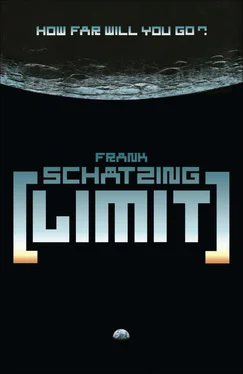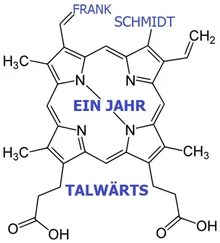They set off and flew rapidly out over the artificial platform, towards the half-built spaceship. They hovered weightlessly between the floodlight masts.
‘We try to limit EVAs to the absolute minimum of course,’ Nina explained. ‘By now, sunstorm forecasts have become accurate enough for us to take them into account during the planning stages of a mission. And in any case, no astronaut goes outside without a dosimeter. If an unexpected eruption takes place there’s still plenty of time to get back inside the station, and there are dozens of armoured storm shelters all around the outer walls of the OSS if it ever gets tight. But then again, even the most high-tech suit doesn’t provide long-lasting protection against radiation damage, so we’re increasingly reliant on robots.’
‘The flying things over there?’ said Locatelli in a shaky voice, pointing in the direction of two machines with arms but no legs, crossing their path a short distance away. ‘They look like goddamn aliens.’
‘Yes, it’s astonishing. Now that reality has emancipated itself from science fiction, it’s picking up its ideas. We’ve realised, for example, that humanoid machines accommodate their creators’ needs in all kinds of ways.’
‘Creation in our own image,’ said Mimi Parker. ‘Just like the boss did it six thousand years ago.’
Something in those crudely chosen words made O’Keefe stop and think, but he decided to worry about it later. They flew in a wide curve and headed for the spaceship. One of the automatons had anchored itself onto the outer shell like a tick. His two main extremities disappeared inside an open shutter, where they were clearly in the process of installing something; two smaller arms around the machine’s upper body were holding components at the ready. The front side of its helmet-like head was adorned with black glassy peepholes.
‘Can they think?’ asked Heidrun.
‘They can count,’ said Nina. ‘They’re Huros-ED series robots, Humanoid Robotic System for Extravehicular Demands . Incredibly precise and utterly reliable. So far there’s only been one incident involving a Huros-ED, and it wasn’t actually caused by it. But after that their circuit board was extended to include a life-saving program. We use them for everything you can think of: servicing, maintenance, construction. If you end up in outer space, you have a very good chance of being picked up by a Huros and brought back safely.’
Their route led them straight up over one of the floodlight masts and over the back of the spaceship.
‘It takes two to three days to get to the Moon by shuttle. They’re spacious, but just for fun try imagining during the flight that you’re on your way to Mars. Six months in a box like that, the sheer horror of it! Human beings aren’t machines; they need social contact, private lives, space, music, good food, beautiful design, food for the senses. That’s why the spaceship being created here isn’t like any conventional ship. Once it’s completed it will be an astonishing size; here you’re only seeing the main body, almost two hundred metres in length. To put it more precisely, it’s constructed from individual elements which are linked up with one another: partly burnt-out tanks from old space shuttles, partly new, larger models. Together they form the working and command area. There will be laboratories and conference rooms, greenhouses and processing plants. The sleep and training modules rotate on centrifugal outriggers around the main body of the ship to allow the presence of a weak artificial gravity, similar to the gravity on Mars. The next construction stage will be to extend it at the front and back, using masts several hundred metres in length.’
‘Several hundred metres?’ echoed Heidrun. ‘Good grief! How long is the ship going to be?’
‘About a kilometre, or so I’ve heard. And that’s excluding the sun wings and generators. Around two-thirds of them are situated on the front mast, at the peak of which there will be a nuclear reactor to provide the power. Hence the unconventional design: the living quarters have to be at least seven hundred metres away from the source of radiation.’
‘And when will the flight be?’ Edwards enquired.
‘Realists have their sights set on 2030, but Washington would prefer it to be earlier. After all, it’s not just a race to get to the Moon. The USA will do everything they possibly can, even if it means…’
‘… occupying the Red Planet,’ completed Rogachev. ‘We get the picture. Has Orley rented the entire hangar to the Americans?’
‘Part of it,’ said Nina. ‘Other areas of the station have been rented to the Germans, French, Indian and Japanese. Russians too. They’re all running research stations up here.’
‘But not the Chinese?’
‘No, not the Chinese.’
Rogachev dropped the subject. Their flight led over the hangar towards the outer ring with its work stations and manipulators. Nina pointed out the far ends of the masts, which sprouted spherical objects: ‘The site and orbit regulation system. Orb-like tanks feed into the thrusters, which can be used to sink, lift or move the station.’
‘But why?’ asked O’Keefe. ‘I thought it had to stay at exactly this height?’
‘In principle, yes. On the other hand, if a meteorite or a particularly big lump of space debris were to come rushing towards us, we would need to be able to adjust the station’s position a little. Generally speaking we would know about things like that weeks in advance. A vertical shift would usually suffice, but sometimes it makes more sense to get out of the way by moving slightly to the side.’
‘That’s why the anchor station is a swimming island!’ called Mimi Parker. ‘So it can be moved around in synchrony with the OSS!’
‘Exactly,’ said Nina.
‘That’s crazy! And does it happen often? That kind of bombardment?’
‘Rarely.’
‘And you’d know the path of all objects like that?’ O’Keefe dug deeper.
‘Well.’ Peter hesitated. ‘The large ones, yes. But small odds and ends pass through here a million times without us needing to know about it: nano-particles, micro-meteorites.’
‘And what if something like that hits my suit?’ Edwards suddenly sounded as if he was longing to be back inside the station.
‘Then you’d have one more hole,’ said Heidrun, ‘and a nicely positioned one, hopefully.’
‘No, the suit can take that. The armoured plating absorbs nano-particles, and if a pinprick-sized hole really did appear, it wouldn’t have any immediate impact. The fabric is interfaced with a polymer layer; its molecular chains close up as soon as the material reaches its melting point. And the friction heat from the impact of a micrometeorite alone would be enough to do that. You might end up with a small wound, but nothing more than you’d get from stepping on a sea urchin or having a run-in with your cat. The chance of crossing paths with a micrometeorite is far less than, let’s say, your chances of getting eaten by a shark.’
‘How reassuring,’ said Locatelli, his voice sounding strained.
The group had crossed the outer edge of the ring and were now following the course of another pylon. O’Keefe would have liked ideally to turn around and go back. There should have been a fantastic view over the roof to the torus from here. But his spacesuit was like a horse that knew the way and went off all on its own. In front of him the pennons spread like a flock of dark glistening birds with mythical wingspans, keeping watch over these curious patches of civilisation in space. And beyond the solar panels that supplied the station with energy, there was only open space.
‘This section should be of particular interest to you, Mr Locatelli. It’s your stuff!’ said Peter. ‘We’d have needed four to five times as many panels using conventional solar technology.’
Читать дальше












